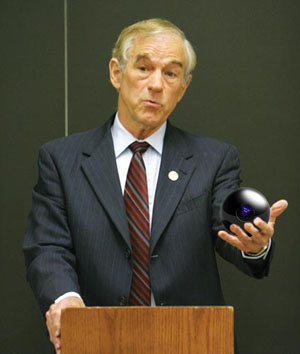
By Nick Li
Apologies for 1948’s recent lack of postings! Ron Paul, the Congressman from Texas running in the Republican Presidential Primary, has been in the news a lot – winning four of the five Republican debates so far according to straw polls and coming fourth in fund-raising due to overwhelming internet support. I support a lot of his positions, and his brand of consistent libertarianism is very seductive – anti-interventionist foreign policy, giving more freedom to people (e.g. gay marriage, legalize drugs) while putting checks on government power (banning torture, warantless wiretaps and eavesdropping, a single mandatory ID-card) – even to those of us on the left. However, on some issues Ron Paul’s ideological libertarianism has led him to advocate positions I find problematic. One of these is his plan to abolish the Federal Reserve and restore America to the gold standard. You can hear Ron Paul describe his position in his own words on Youtube, testifying before Congress or featured in a documentary or read about it here. He comes across as very sensible, and I think it is important to point out where he and other critics of the Federal Reserve are right. In particular:
(a) The Fed has made a lot of mistakes in the past. The role of the Fed in amplifying the downturn of the late 1920s into the Great Depression, is now widely acknowledged due to scholarly works by Milton Friedman and Anna Schwartz among others. Even current Fed Chairman Ben Bernanke recently acknowledged this fact – "I would like to say to Milton and Anna: Regarding the Great Depression. You’re right, we did it. We’re very sorry." David and Christina Romer document the evolution of Fed thinking since 1950, and argue that changes in prevailing beliefs about how the economy works were the key factors influencing Fed decisions – mistaken beliefs led to bad policies on many occasions. Even today many observers, especially the Wall Street Journal, believe that easy money (low interest rate) policies by Alan Greenspan set the stage for the dot-com bubble and bust, and also for the sub-prime and housing bubbles that are making markets jittery today.
(b) The Fed was not explicitly authorized by the US Constitution, but rather by an act of Congress in 1913. [Then again, those who hate paper money should perhaps not put so much stock in a piece of paper written in the 18th century.]
(c) There has been an erosion in the real wage of US manufacturing workers since the 1970s. This does coincide roughly with the end of Bretton Woods and the official abandonment of any fixed-link between the U.S. dollar and gold.
(d) The Fed is quite secretive. It has only become more transparent recently, releasing transcripts of the Board of Governor meetings with a five year lag since 1992.
(e) The classical gold standard (pre-WWI) was very effective at containing inflation compared to fiat (paper) money over the long term – the U.S. dollar lost a lot more value in the 20th century than, say, the 19th century. In fact, the biggest concern under the gold standard was deflation (falling prices) which is virtually unheard of in the modern fiat money era (the two exceptions being the Great Depression and Japan in the 1990s).
(f) The Fed is not really accountable to the Federal government, though the Board of Governors is appointed by the President, and it is certainly not directly accountable to the American public. "Increase the real wages of American manufacturing workers" or "preserve the middle-class" are not parts of its mandate. It has two goals – promote full employment and price stability – and the latter has dominated the agenda since Paul Volcker took over in 1979. Since the people who run the Fed are professional economists or bankers, they may have their ear more attuned to Wall Street and Big Business rather than Main street, though whether they are more subject to this influence is an open question. While Federal Reserve staffers do not rely on votes from the public, they also do not need to solicit campaign donations.
Part Two, a critique of Paul’s positions, to follow –Nick
